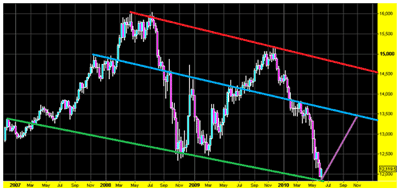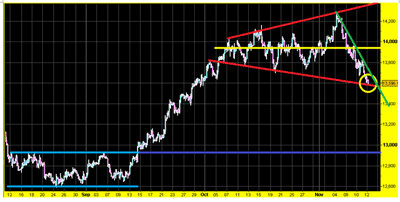As the year 2010 draws nearer to a close, let’s take a look at the market that dominated the majority of the year in the currency arena.
No doubt the majority of the year was dominated by the euro zone debt crisis, which took the euro to under 120, where the currency formed its low for 2010. Greek debt woes made global headlines and the euro was under deep scrutiny. We were happy to be on the short side of the currency’s decline. However, as the euro moved from the 130’s to the 120’s, it was clear to us that it was time to start analyzing its upside potential. Of course, rally days for the euro were few and far between, and with talks of the currency crashing to parity with the dollar, we knew the time was ripe to start looking upside as the headlines of its declines dominated.
So when the currency moved to its lows and entered the numbers of 118, we were announcing our bullish stances to our members. Despite the parity talk, we were more likely to imagine the value of 135 printing again for the euro, and here is that technical chart we analyzed in June 2010:
As the euro rallied, the parity talk virtually died, and so the currency moved towards 135 and in fairness, it overextended our projections by moving towards the 140’s. Of course, the projection itself did come alive, but what brought us to it, and where is the euro heading now?
The chart below is a four-hour chart showing the current state of price:
If you monitor the chart carefully, you can appreciate the light blue lines, which captivate the range in which the euro spent a whole month during August and September, between 126 and 129. It was this very action that led the price to break higher to where it has moved to the 140’s.
This action was going to break one way or another, and generally, the longer the range-bound activity, the greater the move once it breaks away. It was apparent to us and it’s not rocket science to state that the euro was going to eventually break one way or another. We favored upside and that is the direction the euro chose, but from a trading perspective, we didn’t care which way it was going to break away.
Markets do tend to breakout fake out from past experiences, and this can especially be the case for stock markets such as the Dow Jones. However, the general rule of thumb is to measure the size of the range so that the size of the probable move up or down can be projected. Therefore, it wasn’t much surprise to see the euro move towards the 140 circa, which became not just a psychological number, but below it at around 139+, a pivot formed, as shown by the yellow pivot line, in which the market has simply pinged up and down whilst making a recent new high at 14282. This is probably the finest entry ever, but our members were prompted to short at 14280, where the euro started its decline from this point almost instantly, and within a week, the euro has collapsed 600 points. The steep decline is marked by the green, downward-sloping trend line.
Where Now for the Euro?
The chart above shows a wide red triangular formation, which can easily snap to the downside and the recent upward surges could spark a trend change. This trend change would see prices slide to 132 with pure comfort, but we can see the euro head back all the way to the dark blue line from where this very upward month-and-a-half-long move started!
Dollar bears have caused similar slides in the currency to that of the euro in the early parts of this year, and once again, we are happy to start to look for dollar upside potential.
Of course, the euro has a chance of holding this red triangular formation in which some consolidation may take place, however, we would expect the currency to slide lower. At the end of 2008 and at the start of 2009, we saw some volatile moves take place in which upward surges for the currency soon faded into declines, and this time, price action looks to repeat itself in line with the present price action for the euro.
The debt crisis hasn’t vanished, although the scrutiny of it has subsided. We do feel the talk of the debt crisis will largely come back on the agenda, and with it, the euro will feel the relentless pressures of this spotlight.
By Ajit Singh of TradingMarketSignals.com























